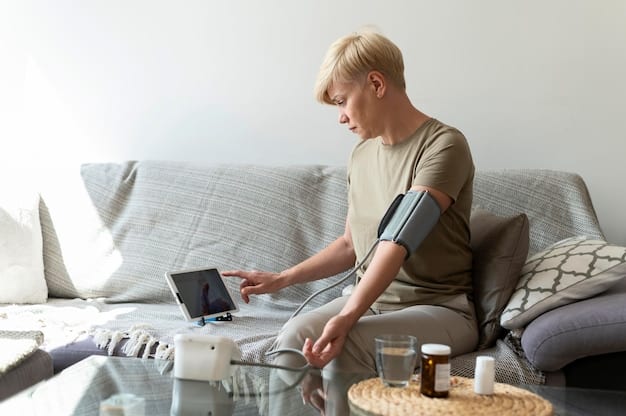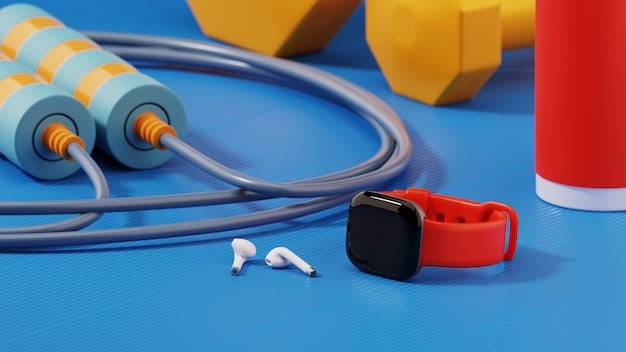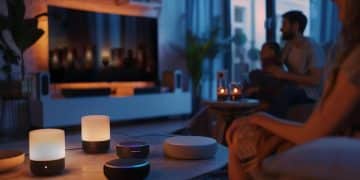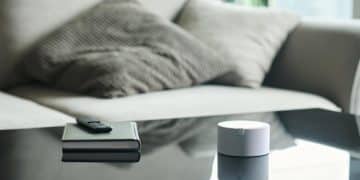Smart Home Health Monitoring: Will Remote Patient Monitoring Become Mainstream by 2025?

Smart home health monitoring is poised to revolutionize healthcare, with remote patient monitoring expected to become increasingly mainstream by 2025, driven by technological advancements, aging populations, and a growing emphasis on preventive care.
Will smart home health monitoring: will remote patient monitoring become mainstream by 2025? Imagine a world where your home actively contributes to your well-being, providing real-time health data and personalized insights, let’s explore how this technology is set to reshape healthcare as we know it.
Smart Home Health Monitoring: An Overview
Smart home health monitoring involves using connected devices to track and manage health metrics within the home environment. These devices can range from simple wearables to sophisticated medical equipment and are used to monitor vital signs, activity levels, sleep patterns, and more.
This technology is transforming healthcare by enabling continuous, remote monitoring of patients, reducing the need for frequent hospital visits and providing timely interventions.
Key Components of Smart Home Health Monitoring
Several key components work together to make smart home health monitoring effective:
- Wearable Sensors: Devices like smartwatches and fitness trackers monitor activity levels, heart rate, and sleep patterns.
- Remote Monitoring Devices: Connected blood pressure monitors, scales, and glucose meters transmit data to healthcare providers, allowing for continuous monitoring of chronic conditions.
- Smart Home Integration: Integration with smart home systems allows for environmental monitoring and adjustments to support health. For example, smart thermostats can adjust temperature to improve sleep quality.
- Data Analytics and AI: Advanced analytics and artificial intelligence (AI) algorithms analyze the collected data to identify trends, predict potential health issues, and provide personalized recommendations.
The combination of these components creates a comprehensive health monitoring system that can significantly improve patient outcomes and quality of life.

The Rise of Remote Patient Monitoring (RPM)
Remote patient monitoring (RPM) is a subset of telehealth that uses technology to monitor patients’ health from a distance. RPM is gaining traction due to its potential to improve patient outcomes, reduce healthcare costs, and enhance access to care, especially for those in rural or underserved areas.
With the advancements in IoT technology and the increasing adoption of smartphones, RPM is becoming more accessible and user-friendly.
Benefits of Remote Patient Monitoring
The benefits of RPM are numerous and impactful:
- Improved Patient Outcomes: Continuous monitoring allows for early detection of health issues, enabling timely interventions and preventing serious complications.
- Reduced Healthcare Costs: By reducing the need for frequent hospital visits and readmissions, RPM can significantly lower healthcare costs.
- Enhanced Access to Care: RPM makes healthcare more accessible to patients in remote areas, those with mobility issues, and individuals who prefer to receive care at home.
- Personalized Care: The data collected through RPM provides healthcare providers with a more comprehensive understanding of a patient’s health, enabling them to deliver personalized care plans.
RPM is set to revolutionize healthcare delivery by empowering patients to take control of their health and enabling healthcare providers to deliver more efficient and effective care.
Technological Advancements Driving Smart Home Health Monitoring
Several technological advancements are propelling the growth of smart home health monitoring. These advancements include improvements in sensor technology, data analytics, and connectivity.
The convergence of these technologies is making smart home health monitoring more accurate, reliable, and accessible.

Key Technological Enablers
Here are some of the key technological enablers that are driving the adoption of smart home health monitoring:
- Advanced Sensor Technology: New sensors are becoming smaller, more accurate, and more energy-efficient, making them ideal for wearable devices and remote monitoring systems.
- Big Data Analytics: The ability to collect and analyze large amounts of health data is enabling healthcare providers to identify trends, predict potential health issues, and deliver personalized care.
- Artificial Intelligence (AI): AI algorithms are being used to analyze health data, provide personalized recommendations, and automate tasks such as medication reminders and appointment scheduling.
- 5G Connectivity: The rollout of 5G networks is providing faster and more reliable connectivity, enabling real-time data transmission and remote consultations.
As these technologies continue to advance, smart home health monitoring will become even more sophisticated and integrated into our daily lives.
Challenges and Obstacles to Mainstream Adoption
Despite the numerous benefits and technological advancements, smart home health monitoring faces several challenges that need to be addressed before it can become mainstream. These challenges include privacy and security concerns, data interoperability issues, and the need for user-friendly devices and interfaces.
Overcoming these challenges is crucial to realizing the full potential of smart home health monitoring.
Key Challenges
Here are some of the key challenges and obstacles to mainstream adoption:
- Data Privacy and Security: Securing sensitive health data and ensuring patient privacy is paramount. Robust security measures and compliance with regulations like HIPAA are essential.
- Data Interoperability: The lack of interoperability between different devices and systems can hinder the seamless exchange of health data, making it difficult to create a comprehensive view of a patient’s health.
- User Adoption: Many patients, especially older adults, may be hesitant to adopt new technologies. User-friendly devices and interfaces, as well as training and support, are needed to encourage adoption.
- Reimbursement Issues: Lack of clear reimbursement policies for remote patient monitoring services can discourage healthcare providers from adopting these technologies.
Addressing these challenges will require collaboration between technology developers, healthcare providers, policymakers, and patients.
The Role of Healthcare Policies and Regulations
Healthcare policies and regulations play a crucial role in shaping the adoption and implementation of smart home health monitoring. Clear and supportive policies can encourage innovation, protect patient privacy, and ensure that these technologies are used safely and effectively.
Governments and regulatory bodies need to develop policies that address the unique challenges and opportunities presented by smart home health monitoring.
Key Policy Considerations
Here are some key policy considerations for smart home health monitoring:
- Data Privacy and Security: Regulations like HIPAA need to be updated to address the unique challenges of protecting health data collected by smart home devices.
- Reimbursement Policies: Clear reimbursement policies for remote patient monitoring services are needed to encourage healthcare providers to adopt these technologies.
- Data Interoperability Standards: Establishing data interoperability standards can facilitate the seamless exchange of health data between different devices and systems.
- Liability and Regulatory Framework: Defining liability and regulatory frameworks are essential to ensure that smart home health monitoring technologies are used safely and effectively.
By addressing these policy considerations, governments can create an environment that fosters the responsible and beneficial adoption of smart home health monitoring.
Predictions and Outlook for 2025 and Beyond
Looking ahead to 2025 and beyond, smart home health monitoring is expected to become increasingly mainstream. Several factors will drive this trend, including the aging population, the rising prevalence of chronic diseases, and the increasing emphasis on preventive care.
By 2025, we can expect to see more sophisticated and integrated smart home health monitoring systems that provide personalized insights and proactive interventions.
Future Trends in Smart Home Health Monitoring
Here are some key trends to watch in the coming years:
- Increased Adoption of Wearable Devices: Wearable devices will become more sophisticated and integrated into daily life, providing real-time health data and personalized recommendations.
- Expansion of Remote Patient Monitoring Programs: Remote patient monitoring programs will expand to cover a wider range of conditions, including chronic diseases, mental health, and post-operative care.
- Integration with Virtual Assistants: Smart home health monitoring systems will integrate with virtual assistants like Alexa and Google Assistant, making it easier for patients to access health information and manage their care.
- Focus on Preventive Care: Smart home health monitoring will play an increasingly important role in preventive care, helping individuals identify and address potential health issues before they become serious problems.
By 2025, smart home health monitoring will be an integral part of the healthcare landscape, providing individuals with the tools they need to manage their health and well-being proactively.
| Key Point | Brief Description |
|---|---|
| 📈RPM Growth | Remote monitoring is growing due to improved outcomes and lower costs. |
| ⚙️Tech Advances | Sensors, AI, and 5G are driving better health monitoring. |
| 🛡️Challenges | Privacy, interoperability, and user adoption are key hurdles. |
| 🏛️Policy Role | Clear policies are needed for data privacy and reimbursement. |
Frequently Asked Questions (FAQ)
▼
Smart home health monitoring uses connected devices to track health metrics, enabling remote patient monitoring and personalized healthcare within the home environment.
▼
Remote patient monitoring involves using technology to monitor patients’ health from a distance, allowing for continuous data collection and timely interventions by healthcare providers.
▼
The benefits include improved patient outcomes, reduced healthcare costs, enhanced access to care, and personalized treatment plans based on real-time health data.
▼
Challenges include ensuring data privacy and security, achieving interoperability between devices, encouraging user adoption, and establishing appropriate reimbursement policies.
▼
Healthcare policies will shape adoption by addressing data privacy, setting reimbursement standards, facilitating data interoperability, and defining regulatory frameworks for technology use.
Conclusion
As we look to 2025 and beyond, the integration of smart home health monitoring promises a transformative shift in healthcare. While challenges remain in ensuring privacy, interoperability, and user adoption, the potential benefits of improved patient outcomes and cost reduction are undeniable, paving the way for remote patient monitoring to become a mainstream practice.





